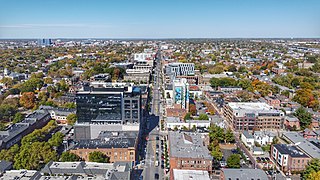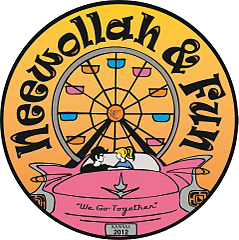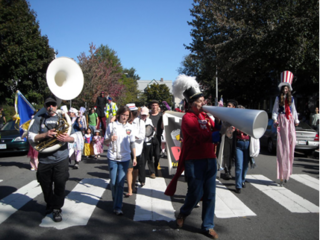Related Research Articles

Neil James Innes was an English writer, comedian and musician. He first came to prominence in the pioneering comedy rock group Bonzo Dog Doo-Dah Band and later became a frequent collaborator with the Monty Python troupe on their BBC television series and films, and is often called the "seventh Python" along with performer Carol Cleveland. He co-created the Rutles, a Beatles parody/pastiche project, with Python Eric Idle, and wrote the band's songs. He also wrote and voiced the 1980s ITV children's cartoon adventures of The Raggy Dolls.

The Short North is a neighborhood in Columbus, Ohio, United States, centered on the main strip of High Street immediately north of the Arena District and extending until just south of the University District and Ohio State University. It is an easy walk from the convention center or Nationwide Arena district to the south, spanning the length of High Street from the north side of Goodale Street to the south side of 7th/King Avenue. It is flanked by Victorian Village to the west and Italian Village to the East. The Short North is a densely-populated commercial and residential district, with especially high pedestrian use during its monthly "Gallery Hop" and other local and downtown events.

Roger Ruskin Spear is an English sculptor, multimedia artist and multi-instrumentalist who was a member of the Bonzo Dog Doo-Dah Band. Spear is the son of the satirical artist and lecturer Ruskin Spear.

Patricia Jean Donahue, known as Patty Donahue, was the lead singer of the 1980s new wave group The Waitresses. She is best known for the band's singles "I Know What Boys Like" and "Christmas Wrapping".

The Pasadena Doo Dah Parade is a popular farcical and flamboyant parade held in Pasadena, California, about once a year.
The Woman's Building was a non-profit arts and education center located in Los Angeles, California. The Woman's Building focused on feminist art and served as a venue for the women's movement and was spearheaded by artist Judy Chicago, graphic designer Sheila Levrant de Bretteville and art historian Arlene Raven. The center was open from 1973 until 1991. During its existence, the Los Angeles Times called the Woman's Building a "feminist mecca."
Cheri Gaulke is a visual artist and filmmaker most known for her role in the Feminist Art Movement in southern California in the 1970s and her work on gay and lesbian families.
Jerri Allyn is an American feminist performance, installation artist and educator based in Los Angeles, California.

Neewollah Festival is an annual festival during the last week of October, in Independence, Kansas.

The feminist art movement in the United States began in the early 1970s and sought to promote the study, creation, understanding and promotion of women's art. First-generation feminist artists include Judy Chicago, Miriam Schapiro, Suzanne Lacy, Judith Bernstein, Sheila de Bretteville, Mary Beth Edelson, Carolee Schneeman, Rachel Rosenthal, and many other women. They were part of the Feminist art movement in the United States in the early 1970s to develop feminist writing and art. The movement spread quickly through museum protests in both New York and Los Angeles, via an early network called W.E.B. that disseminated news of feminist art activities from 1971 to 1973 in a nationally circulated newsletter, and at conferences such as the West Coast Women's Artists Conference held at California Institute of the Arts and the Conference of Women in the Visual Arts, at the Corcoran School of Art in Washington, D.C..
Vanalyne Green is an American artist who also teaches and writes about culture. She has screened her video work extensively in the United States and abroad, including The Whitney Biennial (1991), American Film Institute, Rotterdam International Film Festival, the Videotheque de Paris, The Robert Flaherty Film Seminar, The Guggenheim Museum and many other museums, universities and film festivals. She has received a Guggenheim Foundation fellowship, as well as grants from Creative Capital, the Jerome Foundation, the Richard H. Driehaus Foundation (2003), the National Endowment for the Arts, the New York State Council of the Arts, and a Rome Prize at the American Academy in Rome (2001–2002). Her work has been covered in the Village Voice, the Los Angeles Weekly, The Chicago Reader, and Artforum. Publications by and about, and interviews with, Green also can be found in "Performance Artists Talking in the Eighties" by Linda M. Montano, "Women of Vision" by Alexandra Juhasz, in addition to M/E/A/N/I/N/G: An Anthology of Artists' Writings, Theory, and Criticism. Green's videotape "A Spy in the House that Ruth Built" was listed as one of the 1,000 best films ever made by film critic and author Jonathan Rosenbaum.

Larry Smith, often known as "Legs" Larry Smith is an English drummer of the satirical comedy jazz group the Bonzo Dog Doo-Dah Band.
Colour Me Pop was a British music TV programme broadcast on BBC2 from 1968–1969. It was a spin-off from the BBC 2 arts magazine show Late Night Line-Up. Designed to celebrate the new introduction of colour to British television, it was directed by Steve Turner, and showcased half-hour sets by pop and rock groups of the period. The programme was a pioneering precursor to the better-remembered BBC music programme The Old Grey Whistle Test (1971–87). Unlike its successor, most of the editions of Colour Me Pop are missing, due to the BBC's archival policy of the time.

The Bonzo Dog Doo-Dah Band was created by a group of British art-school students in the 1960s. Combining elements of music hall, trad jazz and psychedelia with surreal humour and avant-garde art, the Bonzos came to public attention through appearances in the Beatles' 1967 film Magical Mystery Tour and the 1968 ITV comedy show Do Not Adjust Your Set.

The TriBattery Pops - Tom Goodkind, Conductor is an all-volunteer community band, and is Lower Manhattan's first such band for over a hundred years. The band's founder and conductor is what songwriter Chris Butler of The Waitresses, once called "a master of shrewd thinking," an apt label for the punk-rocker turned community bandleader.
Nancy Angelo is an organizational psychologist and formerly a performance and video artist who took part in the feminist art movement in Los Angeles. As an artist, she is best known for co-founding the collaborative performance art group The Feminist Art Workers in 1976 with Candace Compton, Cheri Gaulke, and Laurel Klick.
Lesbian Art Project was a participatory art movement founded by Terry Wolverton and Arlene Raven at the Woman's Building in Los Angeles. The pioneering project focused on giving a platform to lesbian and feminist perspectives of participants through performance, art making, salons, workshops and writing. One significant piece of work created during the project was An Oral Herstory of Lesbianism, in 1979, which documented lesbian women and their feelings, views, experiences, and expression.
The Feminist Art Program (FAP) was a college-level art program for women developed in 1970 by artist Judy Chicago and continued by artists Rita Yokoi, Miriam Schapiro, and others. The FAP began at Fresno State College, as a way to address gender inequities in art education, and the art world in general. In 1971, Judy Chicago and Miriam Schapiro brought the FAP to the newly formed California Institute of the Arts, leaving Rita Yokoi to run the Fresno FAP until her retirement in 1992. The FAP at California Institute of the Arts was active until 1976. The students in the Feminist Art Program read women writers, studied women artists, and made art about being a woman based on group consciousness-raising sessions. Often, the program was separate from the rest of the art school to allow the women to develop in a greenhouse-like environment and away from discerning critiques. While the separatist ideology has been critiqued as reinforcing gender, the FAP has made a lasting impression on feminist art which can be seen in retrospectives, group exhibitions, and creative re-workings of the original projects.
Vernita Nemec, also known by the performance name Vernita N'Cognita, is a visual and performance artist, curator, and arts activist based in New York City. She earned her BFA at Ohio University in 1964 and has resided in New York City since 1965. She is also known for her soft stuffed sculpture, collages, artist's books, photographs, and installations. Nemec adopted the pseudonym "N'Cognita," a pun on incognito, as a way to honor artists who have not become well-known.
Leslie Labowitz-Starus is an American performance artist and urban farmer based in Los Angeles.
References
- 1 2 3 4 5 6 Jerri Allyn (2011). "performance art". Jerri Allyn. Otis College of Art and Design . Retrieved 4 Sep 2011.
- 1 2 3 "The Waitresses". Archives. re.act. Retrieved 5 Sep 2011.
- ↑ Montano, 153.
- ↑ "Doin' It In Public". Public Programs. Otis College of Art and Design. Retrieved 16 Sep 2011.
- ↑ Montano, 154.
- ↑ Montano, 155.
- ↑ Jerri Allyn (2011). "Ready to Order?". performance art. Otis College of Art and Design . Retrieved 5 Sep 2011.
- ↑ Sebesta, Judith (2003). "Audience at Risk: Space and Spectators at Feminist Performance". In Kattwinkel, Susan (ed.). Audience Participation: Essays on Inclusion in Performance. Praeger. pp. 149–166.
- ↑ Moravec, Michelle (2011). "In the Name of Love: Feminist Art, the Women's Movement and History". The Waitresses Unpeeled: Performance Art and Life. Otis College of Art and Design. pp. 70–85.
- ↑ Jerri Allyn (2011). "The All City Waitress Marching Band". performance art. Otis College of Art and Design . Retrieved 5 Sep 2011.